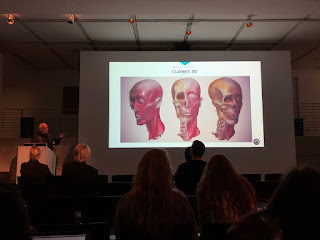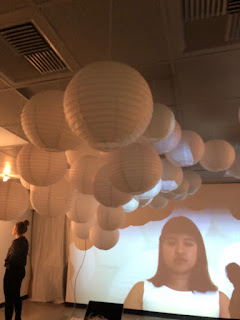Event #2: Fowler Out Loud
I attended the first show of the concert series called Fowler Out Loud, where a jazz collective named Jungle Rhythm performed. They started the show off with an upbeat, playful song that was about a girl who cheated on the lead singer with multiple people related to him. As the show progressed the band explored deeper themes such as depression, the struggles of being first-generation, growing up poor, and love. Music has proven to be an "effective way to express ourselves and cope with challenging life circumstances," and from all the hardships the lead singer has faced in his lifetime, I see how Jungle Rhythm's music came to be so powerful and moving (Warren).
 |
| Jungle Rhythm performing at Fowler Museum |
I began to think of how this performance related to the themes of this class and an obvious connection I made was how science and mathematics created the instruments and electronics used in the performance. The artists wouldn't have the means to convey their art without the technology used to fuel their work. Furthermore, the presence of the internet has made their work a lot more accessible-- a luxury they wouldn't have had just a few decades ago. From a reading posted in Week 3 titled "Relating the Rapidly Changing Present to the Distant Past, as Far as Book History is Concerned," I learned of an interesting statistic that was mentioned in the article: "As of May 2010, cell phones, used by about 90% of American households, were used more for data, such as text messages, streaming video and music, than speech." Good thing Jungle Rhythm formed during this day and age where entertainment is so widely accessible and consumed!
The song about the lead singer's struggles as an immigrant also made me think of a less direct, though still relevant connection between art, science, and mathematics: science and mathematics represents the educated elite and art represents the immigrants, and while they are seemingly separated, they could not exist without each other.
Attendance to this show will help me develop final project ideas through making me think about the real life examples and applications of concepts we have learned in class. I see this show most closely relate to the theme of the first week, especially from C.P. Snow's reading when he warns against dividing the two, art and science, in different realms. In this situation, Jungle Rhythm could not exist without technology, and because art is dependent on technology, their worlds very much coincide.
 |
| Proof of attendance with flyers for the show in the bottom left. |
Sources
Norman, Jerry. “From Gutenberg’s Movable Type to the Digital Book, and Other Studies in the History of Media.” History of Information, Jeremy Norman & Co., Inc, 26 Aug. 2011, www.historyofinformation.com/narrative/index.php.
Warren, Courtney S. “Music Is What Feelings Sound Like.” Psychology Today, Sussex Publishers, 23 Oct. 2014, www.psychologytoday.com/us/blog/naked-truth/201410/music-is-what-feelings-sound.
Snow, C. P. “Two Cultures and the Scientific Revolution.” Reading. 1959. New York: Cambridge UP, 1961. Print.



Comments
Post a Comment